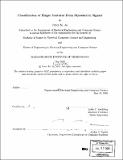| dc.contributor.advisor | Leslie P. Kaelbling. | en_US |
| dc.contributor.author | Ju, Peter M. (Peter Ming-Wei), 1977- | en_US |
| dc.contributor.other | Massachusetts Institute of Technology. Dept. of Electrical Engineering and Computer Science. | en_US |
| dc.date.accessioned | 2005-08-24T19:28:11Z | |
| dc.date.available | 2005-08-24T19:28:11Z | |
| dc.date.copyright | 2000 | en_US |
| dc.date.issued | 2000 | en_US |
| dc.identifier.uri | http://hdl.handle.net/1721.1/9074 | |
| dc.description | Thesis (S.B. and M.Eng.)--Massachusetts Institute of Technology, Dept. of Electrical Engineering and Computer Science, 2000. | en_US |
| dc.description | Includes bibliographical references (p. 73-75). | en_US |
| dc.description.abstract | Electromyographic signals may provide an important new class of user interface for consumer electronics. In order to make such interfaces effective, it will be crucial to map EMG signals to user gestures in real time. The mapping from signals to gestures will vary from user to user, so it must be acquired adaptively. In this thesis, I describe and compare three methods for static classification of EMG signals. I then go on to explore methods for adapting the classifiers over time and for sequential analysis of the gesture stream by combining the static classification algorithm with a hidden Markov model. I conclude with an evaluation of the combined model on an unsegmented stream of gestures. | en_US |
| dc.description.statementofresponsibility | by Peter M. Ju. | en_US |
| dc.format.extent | 75 p. | en_US |
| dc.format.extent | 4734103 bytes | |
| dc.format.extent | 4733862 bytes | |
| dc.format.mimetype | application/pdf | |
| dc.format.mimetype | application/pdf | |
| dc.language.iso | eng | en_US |
| dc.publisher | Massachusetts Institute of Technology | en_US |
| dc.rights | M.I.T. theses are protected by copyright. They may be viewed from this source for any purpose, but reproduction or distribution in any format is prohibited without written permission. See provided URL for inquiries about permission. | en_US |
| dc.rights.uri | http://dspace.mit.edu/handle/1721.1/7582 | |
| dc.subject | Electrical Engineering and Computer Science. | en_US |
| dc.title | Classification of finger gestures from myoelectric signals | en_US |
| dc.type | Thesis | en_US |
| dc.description.degree | S.B.and M.Eng. | en_US |
| dc.contributor.department | Massachusetts Institute of Technology. Department of Electrical Engineering and Computer Science | |
| dc.identifier.oclc | 46824401 | en_US |

